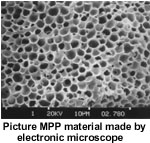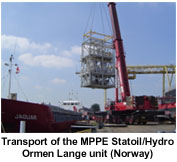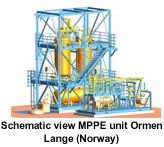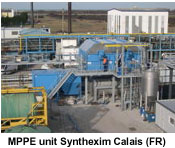Macro Porous Polymer Extraction (MPPE) Technology
The Macro Porous Polymer Extraction (MPPE) Technology is a higly effective, fully automated, remote controlled and guaranteed method for removing dissolved and dispersed hydrocarbons from water with efficiencies of 99.9999% down to below ppb level by means of extraction in an MPP bed
The Macro Porous Polymer Extraction (MPPE) Technology is a highly effective, fully automated, remote controlled and guaranteed method for removing dissolved and dispersed hydrocarbons from water with efficiencies of 99.9999% down to below ppb level by means of extraction in an MPP bed.
With over 80 years accumulated worldwide experiences the MPPE Technology is tested and proven with references by many respected companies.
 The Macro Porous Polymer (MPP) act as carrier for nontoxic and biodegradable extraction medium that absorbs and extracts hydrocarbons from water. The miniscule plastic spheres are capable of reducing contaminant concentrations in water by a factor of more than 1 million, which means that concentrations of thousands ppm (parts per million) can be lowered to below 1 ppb (parts per billion). This is done in only one cycle. Aside from clean water for recycling or discharging, the water purification unit also yields almost 100% pure hydrocarbons suitable for reuse.
The Macro Porous Polymer (MPP) act as carrier for nontoxic and biodegradable extraction medium that absorbs and extracts hydrocarbons from water. The miniscule plastic spheres are capable of reducing contaminant concentrations in water by a factor of more than 1 million, which means that concentrations of thousands ppm (parts per million) can be lowered to below 1 ppb (parts per billion). This is done in only one cycle. Aside from clean water for recycling or discharging, the water purification unit also yields almost 100% pure hydrocarbons suitable for reuse.
MPPE Process Description
Hydrocarbon-contaminated water is passed through a column packed with MPPE particles. The particles are porous polymer beads, which contain a specific extraction liquid. The immobilized extraction liquid removes the hydrocarbons from the water. Only the hydrocarbons, which have a high affinity for the extraction liquid, are removed. The purified water can either be reused or discharged. Periodical in situ regeneration of the extraction liquid is accomplished by stripping the hydrocarbons with low-pressure steam. The stripped hydrocarbons are condensed and then separated from the water phase by gravity. The almost 100% pure hydrocarbon phase is recovered, removed from the system and ready to use/reuse or disposal. The condensed aqueous phase is recycled within the system. The application of two columns allow continuous operation with simultaneous extraction and regeneration. A typical cycle is one hour of extraction and one hour of regeneration.
 Benefits of MPPE Systems
Benefits of MPPE Systems
Very High Separation Performance
Reduction factor 1,000,000 times = 99.9999% removal if required
Cost Competitive
Cost competitiveness proven compared with air stripping and activated carbon, steam stripping and biotreatment systems
Low Energy Concumption
- Low energy input to release hydrocarbons from MPPE particles (in situ renegeration)
- Energy consumption up to 50 times lower than steam stripping
Robust, No Fouling
- Anaerobic operation at ambient temperature. No interference from dissolved iron, heavy metals, surfactants, salt and polar compounds, and no scaling
- No biological fouling because of perodic in situ regeneration by steam
Reliable and Easy Operation
- Fully automated
- Remote control using laptop and mobile telephone
Flexible Operation
Once installed, the unit can treat higher and lower flows and concentrations. For example, if the concentration is 50% higher, effluent requirements can still be maintained with only a 10% lower flow.
At lower feed concentrations, higher flows can be treated while still meeting the effluent demand
Compact Equipment
Compared to existing technologies, the unit is compact with a small footprint
Ideal Upstream Process Integration
Because it is compact, robust, reliable, fully automated, remote controlled, easy to operate and flexible, it is ideal for process, integrated applications
Performance Guarantee during operational lifetime
The material performance is guaranteed during the operational life of the unit irrespective of the number changes of the MPPE material
 Environmental Benefits
Environmental Benefits
- Practically pure separated hydrocarbons for use/reuse
- Low waste of polymer
- Long lifetime
- Reuse of spent material
- Low energy consumption
- Low noise
- No addition of chemicals
- No emission to air
- No sludge formation
- No (chemical iron hydroxide waste
Example of compounds removable with the MPPE technology
 Aromatic and Aliphatic Compounds:
Aromatic and Aliphatic Compounds:
Benzene, Toluene, Ethyl Benzen, Xylene(s), Cumene, Limonene, Nitrobenzene, Cresol(s), Higher alkylated phenols, Octanol, Nonanol, Decanol, Hexane, Heptane, MIBK, TetraHydroTiophene, CS2, Tetramethyltetrahydrofuran, MTBE, etc.
Halogenated/Chlorinated Compounds:
Monochloromethane, Dichloromehane, Trichloromethane, Tetrachloromethane, Dichloroethane (1,1 & 1,2), Trichloroethane, Tetrachloroethane,Chloroethylene, Dichloroethylene, Trichloroethylene,Tetrachloroethylene, Trichloropropane, Chlorobutadiene, Hexachlrobutadiene, Monochlorobenzene, Dichlorobenzen, Chlorobenzenes, Chloroaphtalene, Hexachlorocyclohexane, Monochlorophenol, Dichlorophenol, Trichlorophenol, Dichloro-di-isopropylether, Dioxins etc.
Polyaromatic Hydrocarbons:
PCBs, Naphtalene, Acenaphtylene, Acenaphthene, Flourene, Phenanthrene, Anthracene, Flouranthene, Pyrene, Benz(a) antharacene, Chrysene, Dibenzothiophene, etc.
